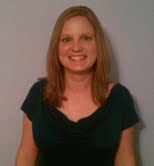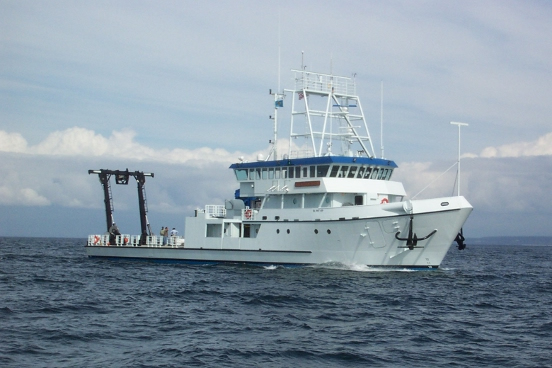NOAA Teacher at Sea
Alicia Gillean
Soon to be aboard R/V Hugh R. Sharp
June 27 — July 8, 2012
Mission: Sea Scallop Survey
Geographical area of cruise: Northwest Atlantic Ocean
Date: Sunday, April 29, 2012
Personal Log
Hello from Oklahoma! My name is Alicia Gillean and I am ecstatic that I was selected as a 2012 NOAA (National Oceanic and Atmospheric Association) Teacher at Sea! I am passionate about adventure, lifelong learning, and the ocean. I can’t wait to merge these three passions together for twelve days at sea this summer and to share my learning with all of my students and coworkers back in Oklahoma. I will be blogging about my adventure and learning while aboard the ship and you are invited to follow my journey and get involved by asking questions and posting comments. I’ll start by telling you a little bit about myself, then I’ll fill you in on the details of my Teacher at Sea adventure.
A Bit About Me
When I’m not pursuing adventure on the high seas, I am the school librarian (also known as a library media specialist) at Jenks West Intermediate School, a school of about 600 5th and 6th graders in the Jenks Public Schools District, near Tulsa, Oklahoma. I might be a bit biased, but I believe that I have the best job in the school and that I work with some of the finest teachers and students in the world.
You are probably wondering, “How did a librarian from Oklahoma become part of an ocean research cruise?” I’m glad you asked. It just so happens that this blog entry answers that very question.
I’ll admit it; I was born and raised a landlubber. There just aren’t many opportunities to visit the ocean when you grow up in the Midwest. Rumor has it that I touched the ocean once when I was about 3, but I didn’t touch it again until I was 21. More on that later.
My passion for the ocean began in high school when I took a Marine Biology class where my mind was blown by the diversity and beauty of life in the sea and the complex network of factors that impact the health of an ocean environment. I took Marine Biology 2 and 3 the following years where I set up and maintained aquariums in elementary schools and taught ocean-related lessons for elementary students.
I started to become a little obsessed with marine life, went to college to become a teacher, and did a happy dance when I learned that an aquarium was going to open in Jenks, Oklahoma. I landed a job as a summer intern in the education department of the Oklahoma Aquarium and was overjoyed to be a part of the team that opened it in 2003. When I graduated from college, the aquarium hired me as an education specialist, where I worked with learners of all ages to promote our mission of “conservation through education” through classes, camps, fishing clinics, sleepovers, animal interactions, crafts… the list goes on and on.
In 2006, I became a 6th grade teacher in Jenks Public Schools, then I earned my Masters degree and became the school librarian in 2010. I love to work with all the kiddos in my school as they learn to develop as thinkers, scientists, and citizens who have the power to impact the world. They are just the kind of advocates that the environment needs and I want to help prepare them for this important role any way possible. My experiences as a Teacher at Sea will certainly help!
Let’s go back to my actual experiences with the ocean for a moment. After graduating from college and marrying my high school sweetheart David, I hightailed it to an ocean as fast as possible. We honeymooned in Hawaii where we snorkeled, explored tidepools, went on a whale watch, and temporarily filled the ocean-shaped void in my heart.
I’ve been back to the ocean several times and each time I am reminded of the delicate balance that must be maintained for the fascinating world under the waves to survive and thrive. It is critical we protect the oceans and that people realize that their actions impact the oceans. Even in the landlocked state of Oklahoma, our actions matter.
So, that’s why a school librarian from Oklahoma will spend the summer of 2012 on a ship in the Atlantic Ocean, counting sea scallops. I can hardly wait for the adventure to begin! Enough about me, let’s talk about the research cruise now.
Science and Technology Log
I’ll be participating in a sea scallop survey in the Atlantic Ocean, along the northeast coast of the United States, from Delaware to Massachusetts. My adventure at sea will begin June 27, 2012 and end July 8, 2012.
What is a sea scallop?
A sea scallop is an animal that is in the same category as clams, oysters, and mussels. One way that sea scallops are different from other animals with two shells (bivalves) is that a sea scallop can move itself through the water by opening and closing its shells quickly. How do you think this adaptation might help the sea scallop? Watch these videos to see a sea scallop in action:
Importance of Sea Scallops/Sea Scallop Survey
People like to eat scallops, so fishermen drag heavy-duty nets along the ocean floor (called dredging) to collect and sell them. Most of them are harvested in the Atlantic Ocean along the northeastern coast of the United States. The United States sea scallop fishery is very important for the economy.
The problem is that sometimes people can harvest too many scallops and the sea scallops can’t reproduce quickly enough before they are harvested again. Eventually, this could lead to the depletion of the sea scallop population, which would be bad news for the ocean and for people.
This is where the NOAA Sea Scallop Survey comes in. Every year, NOAA sends scientists out in a ship to count the number of Atlantic sea scallops (Placopecten magellanicus) in various parts of their habitat. The sea scallops live in groups called beds on the ocean floor 100-300 feet deep, so scientists can’t just peer into the ocean and count them. Instead, they have to dredge, just like the fisherman, to collect samples of scallops in numerous places. The scientists record data about the number, size, and weight of sea scallops and other animals. Based on the data collected, decisions are made about what areas are okay for people to harvest scallops in and what areas need a break from harvesting for a while. I’m considered a scientist on this cruise, so I’ll get to participate in this for 12 hours a day. I hear it is messy, smelly, tiring, and fascinating. Sounds like my type of adventure! I think most good science is messy, don’t you?
The Ship
I’ll be sailing on the research vessel Hugh R Sharp. You can take a virtual tour of the ship here. It was built in 2006, is 146 feet long (a little bit shorter than the width of a football field), and is used for lots of different scientific research expeditions. When I’m out at sea, you can see where I am on the journey and track the ship here.
What I hope to Learn
I’m very interested to experience what daily life is like on an ocean research vessel, how scientists use inquiry, data-collection, math, and other skills that we teach our students in a real-world setting. Of course, I’m also hoping to see some fascinating ocean critters and get my hands dirty doing the work of a real scientist.
I’d love for you to join me on this adventure by following this blog and leaving your thoughts and questions in the comment section at the bottom of each blog entry. Let’s make this a learning experience that we will all remember!






















